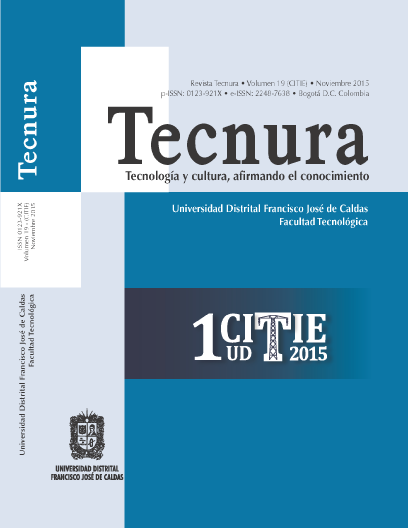DOI:
https://doi.org/10.14483/22487638.9619Published:
2015-11-13Issue:
Vol. 19 (2015): CITIESection:
ResearchVoltimetro true-rms sobre fpga basado en algoritmo cordic
True-rms voltmeter on fpga cordic-based algorithm
Keywords:
True-RMS, FPGA, CORDIC, Algoritmos de Aproximación, Raíz Cuadrada, Vectores. (es).Keywords:
True-RMS, FPGA, CORDIC, Approximation algorithms, square root, vectors. (en).Downloads
Abstract (es)
El cálculo del verdadero valor RMS de una señal de tensión, en corriente alterna, es un asunto de precisión y de accesibilidad. Primero: los resultados pueden alterarse dependiendo del tipo de onda, y segundo: cuando se requiera el procesamiento de operaciones complejas en un multímetro TRUE RMS, por ejemplo, basado en microcontroladores simples, se exige un elevado recurso computacional eventualmente costoso. El presente artículo, describe la investigación que condujo a la implementación de un Voltímetro true-RMS sobre FPGA SPARTAN 3E 1600, utilizando VHDL, que mide con plausible exactitud el valor eficaz de una señal, discretizada con conversor LTC-1407-1A, en circuitos de corriente continua y/o en corriente alterna. La innovación introducida radica en aplicar el algoritmo CORDIC (COordinate Rotation Digital Computer), desarrollado originalmente como una solución digital para los problemas de navegación en tiempo real sobre FPGA (Field Programable Gate Arrays) para las operaciones matemáticas tales como la extracción de raíces cuadradas, entre otras. Se obtiene así un desarrollo sobre un dispositivo digital que es computacionalmente eficiente.
Abstract (en)
The Calculation of true-rms of an AC signal, it's an issue of accuracy and accessibility. First of all: the results can be upset depending of the kind of wave, and second of all: when it's required the complex operations processing on a true-rms multimeter, e.g., based on simple microcontrollers, this requires a high computation resource eventually expensive. This article, describes the research that it routed to the implementations of a true-rms voltmeter on SPARTAN 3E 1600 FPGA using VHDL; it measure with plausible accuracy, the true-rms of a discretized signal with LTC-1407-1A ADC converter, on AC or DC circuits. The innovation is located in apply the CORDIC algorithm (it was developed mainly to resolve navigation problems), FPGA-based to the math operations such as the extraction of square roots, between others. In this way, accessibility and computational efficiency are obtained on the digital device.
References
Akhter, N., Fatema, K., Ferdouse, L., & Khandaker, F. (2010). Implementation of the Trigonometric LMS Algorithm using Original Cordic Rotation. International Journal of Computer Networks Communications, 2(4), 12. Retrieved from http://arxiv.org/abs/1008.3328
Amaya, F., & Velazco, J. (2008). Diseño de la tangente inversa usando el algoritmo cordic.
Andraka, R. (1998). A survey of CORDIC algorithms for FPGA based computers. Proceedings of the 1998 ACM/SIGDA Sixth International Symposium on Field Programmable Gate Arrays - FPGA ’98, 191–200. http://doi.org/10.1145/275107.275139
Chen, D., & Sima, M. Fixed-Point CORDIC-Based QR Decomposition by Givens Rotations on FPGA, 2011 International Conference on Reconfigurable Computing and FPGAs 327–332 (2011). IEEE. http://doi.org/10.1109/ReConFig.2011.38
Cui, X., Yu, D., Sheng, S., & Cui, X. (2006). A CORDIC Demodulator Platform for Digital-IF Receiver. Computer, 2–4.
Edwards, B. (2000). Como multiplican y dividen las calculadoras CORDIC. Enseñanza Universitaria, 159–172.
Gaj, K. (n.d.). Sine / Cosine using CORDIC Algorithm.
Hosticka, B. J. (n.d.). Performance Comparison of MOS/LSI Analog and Digital Signal Processors.
Hu, Y. H., & Naganathan, S. Angle recording method for efficient implementation of the CORDIC algorithm, 42 IEEE International Symposium on Circuits and Systems 99–102 (1989). Ieee. http://doi.org/10.1109/ISCAS.1989.100320
Jridi, M., & Alfalou, A. (2009). Direct Digital Frequency Synthesizer with CORDIC Algorithm and Taylor Series Approximation for Digital Receivers. European Journal of Scientific Research, 30(4), 542–553.
Lakshmi, B., & Dhar, A. S. Parallel CORDIC-like architecture: For fast rotation implementation, TENCON 2011 2011 IEEE Region 10 Conference 701–705 (2011). IEEE. Retrieved from http://ieeexplore.ieee.org/lpdocs/epic03/wrapper.htm?arnumber=6129199
Liu, G., & Feng, Q. (2007). ASIC design of low-power reconfigurable FFT processor. 2007 7th International Conference on ASIC, 44–47. http://doi.org/10.1109/ICASIC.2007.4415563
Maharatna, K., Troya, A., Krstic, M., Grass, E., & Jagdhold, U. (2004). A CORDIC like processor for computation of arctangent and absolute magnitude of a vector. Architecture, 713–716. Retrieved from http://eprints.soton.ac.uk/263544/
Martínez, F.H., Acero, D., & Castiblanco, M. (2015). Robótica Autónoma: Acercamientos a algunos problemas centrales. Publicaciones Universidad Distrital Francisco José de Caldas.
Meher, P., Valls, J., Juang, T.-B., Sridharan, K., & Maharatna, K. (2009). 50 Years of CORDIC: Algorithms, Architectures, and Applications. IEEE Transactions on Circuits and Systems I Regular Papers, 56(9), 1893–1907. Retrieved from http://eprints.ecs.soton.ac.uk/17873/
Park, S. Y. P. S. Y., & Cho, N. I. C. N. I. Fixed-point error analysis of CORDIC processor based on the variance propagation formula, 51 IEEE Transactions on Circuits and Systems I Regular Papers 573–584 (2004). http://doi.org/10.1109/TCSI.2003.820232
Pérez, P. F. (1999). Dispositivos de Medición. In Curso de Capacitacion en Medidas Electrónicas (pp. 1–9).
Sansaloni, T., Pérez, A., Torres, V., & Valls, J. (n.d.). Diseño de un analizador de espectros en FPGA, 6–8.
Volder, J. E. (1959). The CORDIC Trigonometric Computing Technique. Ieee Transactions On Electronic Computers, EC-8(3), 330–334. http://doi.org/10.1109/TEC.1959.5222693
Walther, J. S. (2000). The story of unified CORDIC. The Journal of VLSI Signal Processing, 25(2), 107–112. Retrieved from http://www.springerlink.com/index/K21104P108676P0K.pdf
Wu, C.-S. W. C.-S., & Wu, A.-Y. W. A.-Y. Modified vector rotational CORDIC (MVR-CORDIC) algorithm and architecture, 48 Ieee Transactions On Circuits And Systems Ii Analog And Digital Signal Processing 548–561 (2001). http://doi.org/10.1109/82.943326
Yu, S. Y. S., & Swartzlander, E. E. J. A scaled DCT architecture with the CORDIC algorithm, 50 IEEE Transactions on Signal Processing 160–167 (2002). http://doi.org/10.1109/78.972492
Z Jin, & Z Huajun. (2008). Direct Exponential Function Computer in Neural Network. Information Technology Journal, 7, 1156–1162.
How to Cite
APA
ACM
ACS
ABNT
Chicago
Harvard
IEEE
MLA
Turabian
Vancouver
Download Citation
License
Esta licencia permite a otros remezclar, adaptar y desarrollar su trabajo incluso con fines comerciales, siempre que le den crédito y concedan licencias para sus nuevas creaciones bajo los mismos términos. Esta licencia a menudo se compara con las licencias de software libre y de código abierto “copyleft”. Todos los trabajos nuevos basados en el tuyo tendrán la misma licencia, por lo que cualquier derivado también permitirá el uso comercial. Esta es la licencia utilizada por Wikipedia y se recomienda para materiales que se beneficiarían al incorporar contenido de Wikipedia y proyectos con licencias similares.


